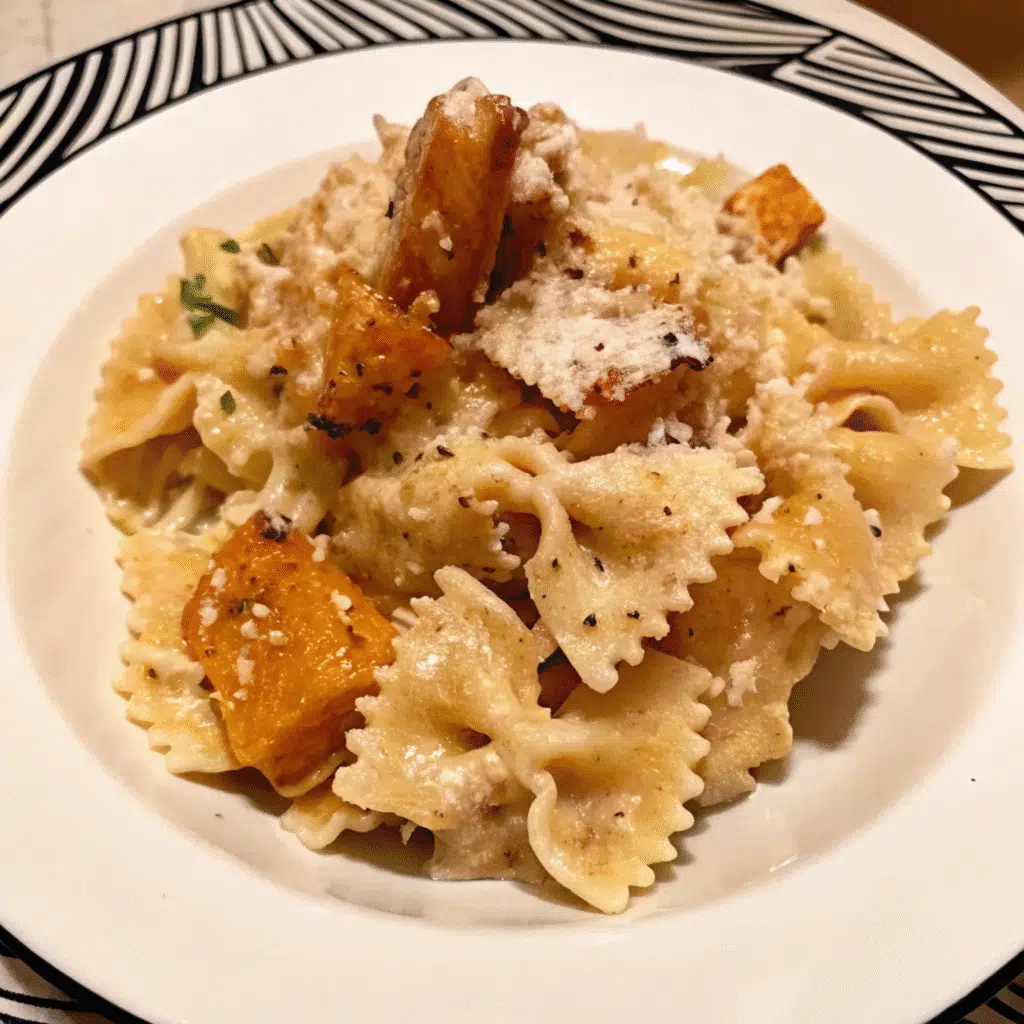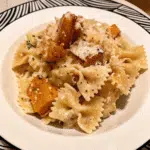This Baked Feta and Butternut Squash Pasta with Sage and Garlic was my quick go-to when I noticed leftover roasted squash and a block of feta in the fridge. My daughter came home from soccer practice starving, so I whipped up something fast that actually satisfied her hunger.
In less than thirty minutes, the feta was perfectly melty and golden, and the squash caramelized into a creamy sauce that wrapped every bite of pasta. By the time we finished, the pan was scraped clean — and my daughter was already asking for seconds.
Love Butternut Squash Recipes? Try my Butternut Squash Sausage Tortellini Soup or this Butternut Squash Lasagna Soup with Kale and Mozzarella next.

Why You’ll Love This Recipe
My kids inhale this pasta because it tastes like the best parts of mac and cheese mixed with actual vegetables they don’t complain about. Everything roasts together in one pan, so you’re basically just chopping squash and waiting around while the oven does the work. Even my husband, who claims he “doesn’t like squash,” goes back for thirds.
Print
Baked Feta and Butternut Squash Pasta with Sage and Garlic
- Total Time: 1 hour
- Yield: 6 cups
Description
A cozy fall pasta dish featuring roasted butternut squash and melted feta cheese tossed with pasta and finished with aromatic sage and garlic. Perfect for weeknight dinners or entertaining!
Ingredients
For the Roasted Base:
- 1 large butternut squash (about 2–3 lbs), peeled and cubed into 1-inch pieces
- 1 block (8 oz) high-quality feta cheese
- 3 tablespoons extra virgin olive oil
- 1/2 teaspoon salt
- 1/4 teaspoon black pepper
- Pinch of red pepper flakes (optional, but I love the little kick!)
For the Pasta & Finishing:
- 1 lb rigatoni, penne, or shells (something that holds sauce well!)
- 4 cloves garlic, minced
- 2 tablespoons fresh sage leaves, chopped (or 1 tablespoon dried sage)
- 1–2 tablespoons hot honey (optional, but OH MY GOODNESS it’s good!)
- 1/2 cup pasta cooking water, reserved
- Fresh cracked black pepper for serving
- Extra feta crumbles for garnish
Instructions
1. Prep and Preheat (5 minutes) Set your oven to 400°F.
2. Prepare the Squash (10 minutes)
2. Prepare the Squash (10 minutes) Peel and cube your butternut squash into chunks about the size of dice. I microwave the whole squash for 2 minutes first because peeling it raw is basically torture. Nobody has time for that on a Wednesday night.
3. Set Up the Baking Dish (3 minutes) Dump the squash cubes in your dish and plop the feta block right in the middle. Drizzle oil everywhere, sprinkle salt and pepper, then those red pepper flakes if you want a tiny kick.
4. First Roast (30 minutes) Stick it in the oven for 30 minutes. The squash should look soft and the feta should be getting warm and slightly puffy.
5. Boost the Heat (5-10 minutes) Crank it up to 450°F for another 5-10 minutes until the feta has golden spots. This is where the magic happens – don’t skip this part or you’ll hate yourself later.
6. Cook the Pasta (10-12 minutes) While that’s finishing up, boil your pasta until it’s just barely done. Save a cup of the pasta water before you drain it – you’ll need this starchy goodness.
7. The Magic Moment (2 minutes) Pull the dish out and immediately dump in the minced garlic and chopped sage. Stir everything together with a wooden spoon and watch the feta turn into the creamiest sauce ever.
8. Bring It All Together (3 minutes) Add the pasta and toss. Pour in pasta water bit by bit until it looks creamy but not soupy. Drizzle honey on top if you’re feeling adventurous.
Notes
Prep shortcut: Buy pre-cut squash from the store – life’s too short
Don’t crowd the pan: Spread everything out or it’ll steam instead of roast
Good feta matters: The cheap stuff gets weird and grainy when heated
Dried sage hack: Add it with the oil before roasting for deeper flavor
Never rinse pasta: You need that starch to make everything stick together
- Prep Time: 15 minutes
- Cook Time: 45 minutes
- Category: Main Dish
- Method: Roasting, Boiling
- Cuisine: Mediterranean-Inspired
Ingredient List
For the Roasted Base:
- 1 large butternut squash (about 2-3 lbs), peeled and cubed into 1-inch pieces
- 1 block (8 oz) high-quality feta cheese
- 3 tablespoons extra virgin olive oil
- 1/2 teaspoon salt
- 1/4 teaspoon black pepper
- Pinch of red pepper flakes (optional, but I love the little kick!)
For the Pasta & Finishing:
- 1 lb rigatoni, penne, or shells (something that holds sauce well!)
- 4 cloves garlic, minced
- 2 tablespoons fresh sage leaves, chopped (or 1 tablespoon dried sage)
- 1-2 tablespoons hot honey (optional, but OH MY GOODNESS it’s good!)
- 1/2 cup pasta cooking water, reserved
- Fresh cracked black pepper for serving
- Extra feta crumbles for garnish
Substitution Notes:
- No butternut squash? Try acorn squash or even sweet potato!
- Feta alternatives: Goat cheese or ricotta work beautifully
- Sage substitute: Fresh thyme or rosemary (use less – they’re stronger!)
- Gluten-free option: Use your favorite gluten-free pasta
Why These Ingredients Work
I use block feta instead of crumbled because it stays put while the edges melt. The butternut squash gets sweet when roasted – my kids actually eat it this way. Fresh sage is worth buying even though it’s pricey because dried tastes like cardboard.
The garlic burns if you add it too early, learned that the hard way. Hot honey sounds weird but makes everything taste better – even my picky eater nephew asks for seconds when I use it.
Essential Tools and Equipment
- Big baking dish (9×13 works)
- Pot for pasta
- Sharp knife
- Wooden spoon
- Something to drain pasta with
That’s it. Don’t overthink this.
How To Make Baked Feta and Butternut Squash Pasta with Sage and Garlic
1. Prep and Preheat (5 minutes) Set your oven to 400°F.
2. Prepare the Squash (10 minutes)
2. Prepare the Squash (10 minutes) Peel and cube your butternut squash into chunks about the size of dice. I microwave the whole squash for 2 minutes first because peeling it raw is basically torture. Nobody has time for that on a Wednesday night.
3. Set Up the Baking Dish (3 minutes) Dump the squash cubes in your dish and plop the feta block right in the middle. Drizzle oil everywhere, sprinkle salt and pepper, then those red pepper flakes if you want a tiny kick.
4. First Roast (30 minutes) Stick it in the oven for 30 minutes. The squash should look soft and the feta should be getting warm and slightly puffy.
5. Boost the Heat (5-10 minutes) Crank it up to 450°F for another 5-10 minutes until the feta has golden spots. This is where the magic happens – don’t skip this part or you’ll hate yourself later.
6. Cook the Pasta (10-12 minutes) While that’s finishing up, boil your pasta until it’s just barely done. Save a cup of the pasta water before you drain it – you’ll need this starchy goodness.
7. The Magic Moment (2 minutes) Pull the dish out and immediately dump in the minced garlic and chopped sage. Stir everything together with a wooden spoon and watch the feta turn into the creamiest sauce ever.
8. Bring It All Together (3 minutes) Add the pasta and toss. Pour in pasta water bit by bit until it looks creamy but not soupy. Drizzle honey on top if you’re feeling adventurous.

Expert Tips
My mom always saved pasta water and I thought she was nuts. Turns out starchy water actually makes everything stick together better. Who knew?
You Must Know
Don’t skip cranking up the heat at the end! That final blast at 450°F is what makes the feta get those golden edges that look amazing in photos. Also, cut your squash pieces roughly the same size or some will be mushy while others are still crunchy.
Personal Secret: I throw in a handful of toasted pine nuts sometimes because the crunch is so good with all that creaminess.
Pro Tips & Cooking Hacks
- Prep shortcut: Buy pre-cut squash from the store – life’s too short
- Don’t crowd the pan: Spread everything out or it’ll steam instead of roast
- Good feta matters: The cheap stuff gets weird and grainy when heated
- Dried sage hack: Add it with the oil before roasting for deeper flavor
- Never rinse pasta: You need that starch to make everything stick together
Flavor Variations & Suggestions
Add protein: Leftover rotisserie chicken or crumbled Italian sausage Go nuts: Pine nuts, walnuts, or toasted hazelnuts for crunch Herb swap: Fresh thyme instead of sage (use less – it’s stronger) Citrus twist: Lemon zest stirred in at the very end Spice it up: Double the red pepper flakes or add diced jalapeño
Make-Ahead Options
Night before: Cut the squash and stick it in the fridge. You can even put together the whole dish minus the pasta and refrigerate overnight.
Day of: The roasted squash and feta mixture keeps in the fridge for 2 days. Just reheat it while you cook fresh pasta.
Freezer stash: The roasted stuff freezes great for up to 3 months. Thaw overnight and reheat before adding fresh pasta.
Recipe Notes & Baker’s Tips
This feeds 4-6 people easily, but I always make the full batch because leftovers taste even better the next day. When you reheat it, add a splash of milk or broth to get that creaminess back.
If your squash is huge and you have extras, roasted butternut squash is amazing in salads or thrown into soup.
Serving Suggestions
I serve this with a simple arugula salad because you need something fresh to cut through all that cheese. A glass of white wine doesn’t hurt either, but honestly it’s just as good with whatever you’ve got in the fridge.
When I’m feeling fancy, I’ll put it in individual dishes with extra sage on top and some good crusty bread on the side for sopping up every last drop.
I hope you try this recipe and actually like it. Let me know if you change anything – I’m always stealing ideas from other people’s variations!
How to Store Your Baked Feta and Butternut Squash Pasta
Fridge: Keeps for 4 days in a container. Actually tastes better the next day.
Reheating: Add some milk or water when you reheat it or it gets weird and clumpy. Microwave works fine, just stir it halfway through.
Freezing: Don’t freeze the whole thing – the pasta gets gross. But the squash and feta part freezes great for up to 3 months.
Allergy Information
Has: Dairy and gluten
No dairy: Use vegan feta or just skip the cheese and add nutritional yeast No gluten: Any gluten-free pasta works – chickpea pasta is actually really good No nuts: This doesn’t have nuts unless you add them
Questions I Get Asked A Lot
Can I use the pre-cut squash from the store?
Yes! I do this all the time because peeling squash sucks. Just check that the pieces aren’t too big.
What if I can’t find block feta?
Crumbled works but mash it together in the middle of the pan. Won’t be as creamy but still good.
How do I know when the squash is done?
Stick a fork in it. If it goes through easily and the edges look a bit brown, you’re good.
Do I have to use the honey?
No, but try it once. I was skeptical too and now I put it on everything.
What pasta shape works best?
Short chunky ones like penne or rigatoni. Long skinny pasta doesn’t hold the sauce as well.
💬 Made this? Tell me how it went! Did you change anything? Add different stuff? I’m always looking for new ideas to steal.

